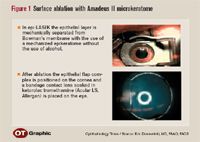Article
Conventional LASIK, epi-LASIK, lamellar epithelial debridement possible with same tool
New York-The latest upgrades to the Amadeus II microkeratome (Advanced Medical Optics) offer surgeons the flexibility to perform epi-LASIK and lamellar epithelial debridement as well as conventional LASIK without adding a new handpiece or control box. The only new components required are a small holder for the separator used in epi-LASIK as well as a new head, both of which are part of the package when the Amadeus II is purchased, according to Eric Donnenfeld, MD, FAAO, FACS, Ophthalmic Consultants of Long Island.

"One of the nicest advances with the Amadeus II is the ability to do surface ablation with lamellar epithelial debridement or epi-LASIK," Dr. Donnenfeld said. "With the addition of the patented epi-LASIK head, you can now create a very clean, very reliable smooth surface with almost no risk of stromal invasion, which you sometimes see with other epi-LASIK devices."
Lamellar epithelial debridement is an advanced surgical technique in which the flap is removed prior to performing surface ablation. This technique produces a very smooth and regular epithelial debridement.

"With the Swiss engineering, they've been able to tighten it up to an even greater extent so that the standard deviation of flaps made with the Amadeus II keratomes is now around 10 μm, which is about the same as you have with the femtosecond laser," Dr. Donnenfeld said. He is co-director of the Cornea Department at Nassau University Medical Center, East Meadow, New York, and co-director of the External Disease/ Cornea Department at Manhattan Eye, Ear and Throat Hospital, New York. He is also the surgical director of the Lions Eye Bank for Long Island at the North Shore University Hospital and is an assistant clinical professor of ophthalmology at New York University Medical College.
Viable epithelial flaps
In a recent study of the Amadeus II microkeratome with the new epi-LASIK head attachment, Dr. Donnenfeld and colleagues were able to achieve viable epithelial flaps in 38 of 40 patients, the epithelial defect size was reliable, and there was a zero incidence of stromal occurrences.
The controls of the Amadeus II are so flexible that it can easily accommodate the different types of epithelial removal procedures, Appler said, and Dr. Donnenfeld said he has observed this flexibility while performing procedures with the upgraded keratome.
The ability to adjust surgical parameters such as oscillation speed, translation speed, and suction and create different flap thicknesses and diameters gives surgeons extensive control over the procedure, he explained. In their study, the investigators found that they achieved the best results by reducing the translation speed to 1.5 mm/second and maintaining the oscillation speed at about 11,000 rpm.
"The ability to have more surgeon control over flap parameters is one of the major advantages of the Amadeus II," Dr. Donnenfeld said. "It really gives surgeons the ability to titrate almost any aspect of the flap to their surgical needs.
Newsletter
Don’t miss out—get Ophthalmology Times updates on the latest clinical advancements and expert interviews, straight to your inbox.




